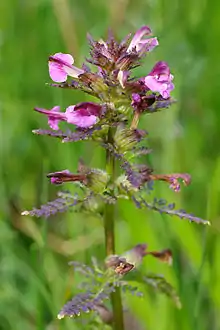Pedicularis palustris
Pedicularis palustris, commonly known as marsh lousewort, is a plant species in the family Orobanchaceae.[2] It is native to central and northern Europe and Asia where it grows in wetlands and boggy habitats. The International Union for Conservation of Nature has assessed its conservation status as being of least concern.[1]
| Marsh lousewort | |
|---|---|
 | |
| Scientific classification | |
| Kingdom: | Plantae |
| Clade: | Tracheophytes |
| Clade: | Angiosperms |
| Clade: | Eudicots |
| Clade: | Asterids |
| Order: | Lamiales |
| Family: | Orobanchaceae |
| Genus: | Pedicularis |
| Species: | P. palustris |
| Binomial name | |
| Pedicularis palustris Carl Linnaeus, 1753 | |
Description
The nominate subspecies P. palustris palustris, which occurs in the west of the range, is a straggly biennial herb with a much-branched, usually erect stem up to 60 cm (24 in) tall. The leaves are alternate or opposite, with a short stalk. The leaf blades are triangular-lanceolate to linear, with pinnate lobes and toothed margins. The inflorescence is a raceme with leaf-like bracts. Each bilaterally symmetrical flower has a short stalk and a large, rounded, toothed calyx. The flower is reddish-purple and up to 2.5 cm (1 in) long, with five petals fused into a tube, the upper lip being slightly shorter than the lower lip. The fruit is a capsule. The other subspecies, P. palustris karoi, which occurs in the east of the range, is an annual plant and has smaller flowers.[3] This species can be distinguished from common lousewort (Pedicularis sylvatica) by having two calyx lobes rather than four, and four small teeth at the tip of the upper lip rather than two. It is also taller and more erect, and is found in wetter locations.[2]
Distribution and habitat
Marsh lousewort is found in central and northern Europe and Asia. In Europe, it occurs in Scandinavia and southwards through most of Europe at altitudes of up to 1,200 m (4,000 ft).[1] In the British Isles, it mostly occurs in Scotland, Ireland, Wales, western England and East Anglia. In Asia, it occurs in Russia, Kazakhstan, Mongolia and northern China. Typical habitat is wetlands, swamps, fens, marshes, wet meadows and ditches.[3]
Ecology
Marsh lousewort is a semi-parasitic plant, the roots sucking nourishment from adjacent plants. The flowers are pollinated by honey bees and bumblebees; these land on the lower lip, which droops under their weight allowing them to thrust their head inside the flower and extract the nectar, getting powdered with pollen at the same time.[4]
References
- Lansdown, R.V. (2014). "Pedicularis palustris". IUCN Red List of Threatened Species. 2014: e.T19620542A19621146. doi:10.2305/IUCN.UK.2014-1.RLTS.T19620542A19621146.en. Retrieved 24 October 2020.
- Farmer, Carl. "Marsh Lousewort: Pedicularis palustris". West Highland Flora. Retrieved 27 January 2020.
- "Pedicularis palustris Linnaeus, 1753". Flora of China. Retrieved 27 January 2020.
- "Marsh lousewort: Pedicularis palustris". NatureGate. Retrieved 28 January 2020.
